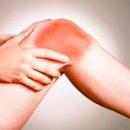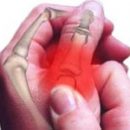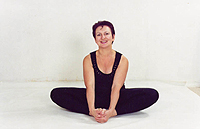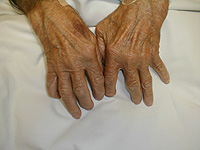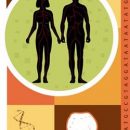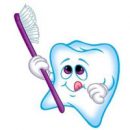Did you think that careless attitude towards health care can lead to osteoarthritis of foot joints. Precooling, wearing uncomfortable shoes on high heels, sports, overweight - all these are the causes of the development of arthrosis of the thumb, called people «Bone».
Content
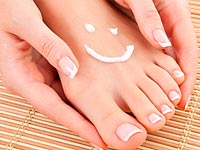 «Bones» At the base of large fingers, the stop appear for various reasons, but in most cases they are a consequence of the deforming osteoarthrosis of the toll-line-balance joints and are accompanied by a deviation of the dust. More often the disease occurs in women and the reason for this becomes wearing uncomfortable model shoes with a narrow nose and high-heeled. However, this is not all factors that can serve as an impetus for the development of the arnotic of the thumb.
«Bones» At the base of large fingers, the stop appear for various reasons, but in most cases they are a consequence of the deforming osteoarthrosis of the toll-line-balance joints and are accompanied by a deviation of the dust. More often the disease occurs in women and the reason for this becomes wearing uncomfortable model shoes with a narrow nose and high-heeled. However, this is not all factors that can serve as an impetus for the development of the arnotic of the thumb.
Why arises osteoarthritis of foot joints?
The causes of arthrosis of the thumb as, however, the osteoarthrosis of other foot joints echoes the etiology of degenerative-dystrophic diseases in general. However, in the first place in the list of pathogenic factors is a joint microtrauma.
- Wearing a narrow shoe, compressing a foot in the field of advantage of the faving joints.
- Wearing a shoe on a heel, redistributing the load on various parts of the foot, overloading the tienefaulating joint and provoking arthrosis of large and often the second finger.
- Flatfoot, and more often longitudinal than transverse, breaking foot biomechanical.
- Long vertical load on the foot, for example, walking over long distances, work involving a standing position that form a flat foot.
- Chronic microtraums of joints as a result of professional activities. For example, athletes and ballet dancers osteoarthritis of thumb are quite frequent.
- Sharp injuries to Sustava.
- Hugging foot.
How does arthrosis of thumb?
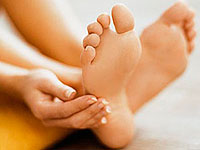 All of the above factors involve the immediate destruction of the articular cartilage in combination with inflammation and impaired circulatory circulation, leading to dystrophy and subsequent degeneration of cartilage tissue. As a result of a decrease in the depreciation stability of the articular cartilage and an increase in the load on the bone, forming the joints, osteophytes are formed, which deform the joint and contribute to the further deviation of the thumb of the foot. The subsequent destruction of bone tissue is accompanied by the formation of cystic cavities, the development of arthritis and the further progression of the disease.
All of the above factors involve the immediate destruction of the articular cartilage in combination with inflammation and impaired circulatory circulation, leading to dystrophy and subsequent degeneration of cartilage tissue. As a result of a decrease in the depreciation stability of the articular cartilage and an increase in the load on the bone, forming the joints, osteophytes are formed, which deform the joint and contribute to the further deviation of the thumb of the foot. The subsequent destruction of bone tissue is accompanied by the formation of cystic cavities, the development of arthritis and the further progression of the disease.
X-rayly deforming osteoarthritis of the PlusNeflangy Sustav of the foot is manifested by the narrowing of the joint gap, the formation of boundary springs of bone tissue, the degeneration of the joint. Bone expansions are formed mainly on the back and plantar side of the exterior department of the joint. In the inner plot, they appear only if the position of the bones formed by the joint remains normal.
What are the manifestations of osteoarthrosis of the Plyusnelagovaya joint?
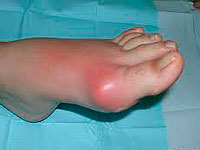 Arthrosis — Disease chronic, exacerbated and accompanied by inflammation of the joint. For this stage, pain, swelling and redness of the skin are becoming typical of the disease. Movements in the advantage of high-balance articulation become painful and limited, which leads to the appearance of chromotype. During the period of remission, there is an increased fatigue, pain after excessive load, bone articulation deformation.
Arthrosis — Disease chronic, exacerbated and accompanied by inflammation of the joint. For this stage, pain, swelling and redness of the skin are becoming typical of the disease. Movements in the advantage of high-balance articulation become painful and limited, which leads to the appearance of chromotype. During the period of remission, there is an increased fatigue, pain after excessive load, bone articulation deformation.
In its development, the advantage of Eassearthrosis takes place several stages.
Stage I Stage — At this stage, the disease is manifested by fast fatigue, periodic pain in the joints associated with the load, pressure, but these symptoms disappear after rest.
Stage II — Osteoarthritis generally and arthrosis of the Plyusnelaglading joint in particular is characterized by more pronounced painful sensations, only slightly weakening during rest. The joint is riveted, deformed, the finger deflects the dust and a book.
III Stage — The disease leads to a pronounced joint strain and constant pain. It makes it give up the model shoes and limits physical activity. Trying to unload the struck joint, patients with walking the body weight on the outdoor side of the foot, as a result of which painful corns appear on the base surface 4 and 5 fingers.
Arthrosis of the first finger of his legs abruptly limits the physical possibilities of the patient, but does not lead to disability.

